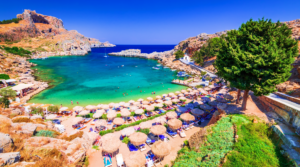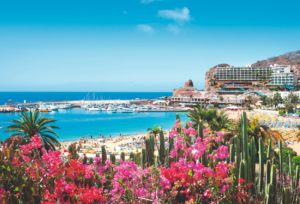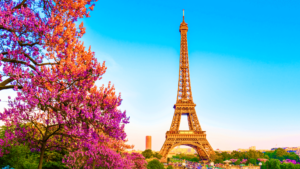The stunning Canary Islands just off the coast of West Africa have long been a fashionable holiday destination for British tourists. They are drawn to the dramatic landscapes, beautiful beaches and fantastic warm temperatures. However there is a secret hidden amongst these popular islands, so secret that many people will have never even heard of it, and even fewer will have ever discovered.
La Gomera is the second smallest Canary Island, behind El Hierro, and can best be described as rugged and earthy yet tropical and lush, combining a volcanic nature with gentle velvety green overtones to perfection. This dazzling jewel shines perfectly in the vast expanse of the magnificent Atlantic Ocean.
The island is only 15 miles in diameter and rises to 5,000 feet at its highest point in Garajonay National Park. Its volcanic origin has ensured that the land resembles the segments of an orange, with sections of deep rocky ravines spilling down into the ocean, interspersed by hills of verdant rainforests.
The temperate year round climate makes La Gomera the perfect destination whenever you feel like travelling, with September to May being the finest times to see the island at its very best. July and August are the hottest months on the island and temperatures can regularly top 30°, this is also the favourite time for Spanish nationals to take their holidays to La Gomera. The trade winds help to keep the north of the island slightly cooler than the south, and during winter months the mountainous region can become quite cool.
Accommodation on the island is mainly in diminutive hotels; self catering apartments or small houses, there are no large hotel complexes here, keeping the island welcoming and intimate.
Getting to the island is very easy and usually entails a flight to Reina Sofia in southern Tenerife, then a short ferry ride over to La Gomera. Alternatively some airlines will fly you into Los Rodeos in northern Tenerife where you can catch a connecting flight over to the island’s tiny airport. For the even more adventurous you can drive to southern Spain and catch the car ferry to La Gomera. You also have the benefit of having transport on the island which could be perfect for longer stay vacations. Don’t worry though, you don’t need your own transport as cars are easily hired once on the island, or why not explore by bike or on foot.
Keen Mountain bikers are in their element on La Gomera holidays with plenty of old donkey trails carved into the landscape to test their skills. There are routes for every level of competence and organised day tours can be booked with local cycle guides to ensure you get the very best from your cycling experience.
Guides are also on hand to take you on picturesque hiking tours, another perfect way to explore the island whilst taking in its utterly breathtaking beauty. Their expertise will keep you up to date with the history of the island, local wildlife and information on fascinating plants and animals. The Garajonay National Park is the perfect place for a La Gomera hike. The romance is unsurpassed as you discover the islands hidden love story.
In true Romeo and Juliet style, the park and mountain are named after the young lovers Gara and Jonay. Gara was a La Gomeran princess and during a ceremony where young ladies of the island would gaze into the waters of Chorros del Epina at their reflection, to determine whether they would marry, she stared too long and the dazzling sun momentarily blinded her. This was seen as an omen and she was warned to avoid all fire. Jonay was visiting the island from Tenerife when he met and fell in love with Gara, however just as they announced their engagement, the nearby mount Teide on Tenerife erupted as though in disapproval and Jonay’s father ordered him back to his homeland. The lovesick young man later swam back to La Gomera to be reunited with his love. When their parents ordered that they be found, they became trapped on the mountain and took their own lives.
Whilst we rely on mobile phones to communicate in this day and age, the Gomerans use whistling. Due to the steep hills and valleys a method of communicating was developed as far back as the 15th century which enabled the islanders to communicate without speaking, they used whistling to avoid the Spanish conquistadors, warn of impending invasion, relay news of births and deaths and also to sell goats. Many of the elder islanders can still communicate in this way but as with many customs of yesteryear it is a dying art, however to keep the tradition alive, classes are available and it has also been added to the primary school syllabus.
La Gomerans are a friendly and very welcoming bunch and their fierce passion and devotion to their island means they will protect the natural beauty of their island, whilst ensuring it is a wonderful and inviting destination on the Canary island tourist trail.






